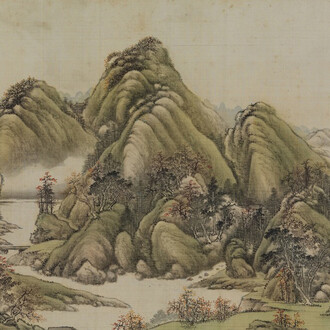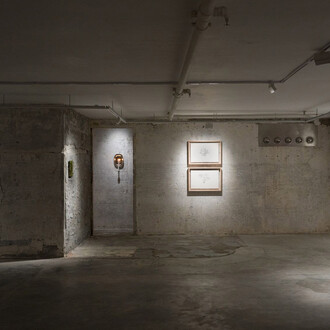This is the first ever joint exhibition of Hong Kong’s three preeminent collections of ancient paintings and calligraphies, honouring specifically Low Chuck-tiew’s Xubaizhai, Ho Iu-kwong’s Chih Lo Lou and Lee Jung-sen’s Bei Shan Tang. On display is a selection of 93 sets of masterpieces spanning from the Tang dynasty to the Qing to offer visitors a rare opportunity to sample the distinctiveness of the Three Preeminent Collections all at once.
Greatly revered by academics and collectors, the three preeminent collections, or the Three Preeminent for short, have been individually showcased at major museums around the world, including the Shanghai Museum, The Palace Museum, Musée Cernuschi and The Metropolitan Museum of Art, in association with large-scale international symposia.
In the mid-20th century, Chinese national treasures were massively draining into Hong Kong for onward transmission to the West. Alarmed by such losses to overseas countries, the three collectors resolved to salvage ancient Chinese masterpieces in the hope of keeping these embodiments of Chinese heritage on home soil. The Three Preeminent were thus born.
Despite the monetary worth involved, the three collectors and their families donated their invaluable collections to public museums so as to make possible public access to the once privileged treasures. The Xubaizhai and Chih Lo Lou Collections are now housed in the Hong Kong Museum of Art whereas the Bei Shan Tang Collection has been substantially donated to the Art Museum, The Chinese University of Hong Kong. While highlighting the important role that Hong Kong played in the preservation of traditional Chinese art, this exhibition aims to salute these Hong Kong collectors for their noble selfless acts.
In order for this unique story of collecting to be retold in a contemporary perspective, the Hong Kong Museum of Art has commissioned the artist Yau Wing-fung to create two installations, namely To and Fro and Mirage Harmony, to extend the scenes captured in Huang Xiangjian’s depictions of his reunion journeys in the Three Preeminent with landscape constructions.
Geographical location and historical background combined to turn Hong Kong into a hub for paintings, calligraphies and other artefacts in mid-20th century. At the time, political turmoil triggered a massive drain of artefacts into the territory, opening up a golden opportunity for local collectors, newly arrived Mainlanders and overseas buyers to acquire rare treasures. It was during this period that Low Chuck-tiew’s (1911 – 1993), Ho Iu-kwong’s (1907 – 2006) and Lee Jung-sen’s (1915 – 2007) widely collected the precious artworks, which became the three preeminent collections of Hong Kong. They were built out of either a passion for painting and calligraphy or a self-imposed mission to preserve and promote Chinese heritage.
The three collections have achieved resounding fame around the world and have occupied an important place in the modern Chinese history of collecting. They are testimonies to not only Hong Kong’s golden age of collecting but also its role in the conservation of Chinese culture and heritage. Much more than making available their collections for display and scholarly activities, the masters of the three preeminent collections honoured through this exhibition have all donated their invaluable collections to the Hong Kong Museum of Art or the Art Museum of The Chinese University of Hong Kong for the benefit of the general public. Their selfless and generous contribution to the preservation of Chinese culture and heritage deserve our utmost gratitude and admiration.
Unprecedented in history for bringing together Xubaizhai, Chih Lo Lou and Bei Shan Tang in a single exhibition, The pride of Hong Kong: three preeminent collections of ancient paintings and calligraphies features a selection of 93 sets of painting and calligraphic classics. Decidedly a spectacle for Hong Kong’s painting and calligraphy communities, the show explores the significant role that the city has been playing in the preservation of traditional Chinese art and salutes the altruism of the Hong Kong collectors who donated their prized possessions to public institutions.
Thanks to sponsorship by the Bei Shan Tang Foundation, the exhibition is accompanied by a catalogue and an international lecture series by local, Mainland and overseas scholars to facilitate in-depth understanding and appreciation of ancient Chinese painting and calligraphy and to provide a global historical context to Chinese painting and calligraphy collecting.
Inspired by the late Ming and early Qing painter Huang Xiangjian’s depictions of his reunion journeys in the three preeminent collections, Hong Kong artist Yau Wing-fung has created two installations To and fro and Mirage harmony to retell the unique story from a contemporary perspective. To and fro is a cyclical installation that extends the spatial confines of landscapes captured in Huang’s reunion journeys through the use of segmented blue-and-green and outlined landscapes. Taking reference from the varied perspectives and stylised rocks and mountains in the reunion paintings, the distinctive landforms of Hong Kong’s 18 administrative districts are each metaphorically reconstructed into a pictorial landscape for installation in a dedicated space in Mirage harmony.
















